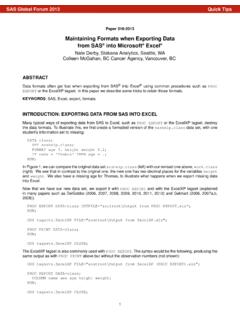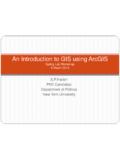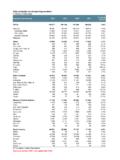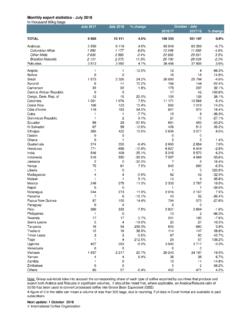Transcription of Moving Data From Excel To SAS
1 Moving data From Excel To SAS. And Back Again By Ben Cochran The Bedford Group 1. Contents 1. Using DDE to Import Excel data 2. Using the Import / Export Wizard 3. Using PROC IMPORT / EXPORT. 4. Using Enterprise Guide 5. Using the Add-in for MicroSoft Office Product 6. Using the Excel Engine triplet . 2.. 2. 2. Using DDE to Import Excel data Dynamic data Exchange (DDE) is a way of dynamically exchanging information between Windows applications. You can use DDE with: the data step the SAS Macro facility a SAS/AF application any operation in the SAS System that requests and generates data To use DDE in SAS, issue a FILENAME statement with this general form : FILENAME fileref DDE DDE-triplet ' | CLIPBOARD' < DDE - options > ;. where: fileref is any valid fileref DDE is a required keyword DDE- triplet ' | CLIPBOARD' is the name of the DDE external file DDE - options include HOTLINK, NOTAB, COMMAND. triplet . 3. For more information on DDE options, refer to SAS Companion for the Microsoft Windows Environment from SAS Institute.
2 3. Using DDE to Import Excel data The DDE triplet is application dependent and takes the following form : application - name | topic ! item . where: application - name winword (for MS Word) or Excel (for Excel spreadsheets). topic is the topic of conversation between SAS and the DDE. application typically the full path filename of the file. item is the range of conversation. For example, in a spreadsheet this is usually a range of cells. To determine the exact value of the DDE triplet for a spreadsheet application, do the following: from the spreadsheet, select the range of cells, then copy them into the clipboard, go to the command line / bar in SAS and issue the DLGDDE command: DLGDDE . example . 4. 4. Using DDE to Import Excel data Task: Read a range of cells from located in c:\unzipped'. The range is from row3, column1 to row19 column4. The spreadsheet is shown below. pgm . 5. 5. Using DDE to Import Excel data Look closely at the FILENAME statement. filename in dde ' Excel | c: \ unzipped \ [ ]Sheet1!
3 R3C1:R19C4';. data spreadsheet_test;. infile in dlm='09'x notab dsd missover;. input start_date: mmddyy10. start_amt end_amt blank $;. run;. proc print data =spreadsheet_test;. format start_date weekdate25.;. run;. where: notab tells SAS not to convert the tabs sent from Excel into blanks, dlm defines the delimiter as hexadecimal representation of the tab character. dsd tells SAS to treat 2 consecutive delimiters as a missing value missover tells SAS to set all variables in the current observation to missing if values are not found in the current record or row. Note: with this approach, the spreadsheet needs to be open. log . 6. 6. Using DDE to Import Excel data output . 7. 7. Using DDE to Import Excel data The example on the next page shows a DDE application that Opens a spreadsheet, reads it, then closes it . 8. 8. Using DDE to Import Excel data . 9. 9. 2. Using the Import / Export Wizard Demo triplet . 10. 10. 3. Using PROC IMPORT / EXPORT. Demo triplet . 11.. 11. 4. Using Enterprise Guide Demo: Bringing Excel data into EG.
4 Triplet . 12. 12. Exporting Datasets to Excel From within the Enterprise Guide project, select the dataset you want to export to Excel . Click on it and select Export Export dataset name As A Step in Project .. 13. Exporting Datasets to Excel From the Export window, first select the dataset you want to then select A Next> . 14. 14. Exporting Datasets to Excel Next, select the type of file ( Excel ) for the output file . then select Next>. 15. 15. Exporting Datasets to Excel Choose whether you want to use the column names or column labels as headers in the new file . Select Next> . 16. 16. Exporting Datasets to Excel Select a location for the new spreadsheet. Select Next> . 17. 17. Exporting Datasets to Excel Verify the correctness of the then select Finish. 18. 18. Exporting Datasets to Excel When the Process Flow window reappears, the Export File task is in place.. 19. 19. 5. Using The Add-in for Microsoft Office Product triplet . 20. 20. Overview The objectives for this section include: Illustrate the capabilities of the SAS Add-in for Microsoft Examine the SAS servers available from the SAS Add-in for Microsoft.
5 Office Q. What does it do? A. Extends the capabilities of Microsoft Office by enabling the user to harness the power of SAS data sources from within Microsoft Word and Excel . Q. Why is it Important? A. There are many business users who can benefit from the power of the SAS system, but they are not comfortable working in a traditional programming environment. The SAS add-in brings SAS analytic capabilities to the Microsoft Office environment. 21. 21. Objectives Q. What are the Capabilities? A. You can: 1. Create SAS reports in Microsoft Office applications using stored .processes, 2. Access SAS data sources. 3. Access non-SAS data sources that are available from the SAS Server. 4. Analyze SAS or Excel data using analytic tasks. Q. What are the requirements? 1. Windows NT4, Windows 2000, Windows XP, 2. Office 2000 or greater. 3. SAS Add-in for Microsoft Office. 22. 22. The Typical Environment Desktop Clients Java Applications Windows Apps Web Browser Apps 1. SAS Management Console 2.
6 ETL Studio 5. Enterprise Guide 7. Web Report Studio Client 6. Add-in for MSOffice 8. Information Deliver. Portal 3. SAS OLAP Cube Studio Tier 4. SAS Info. Map Studio Middle Tier 1. R R O O O. Server Metadata Workspace Stored Process OLAP SAS/Connect Tier Server Server Server Server Server Web Server Ganesh / SASEGS erver SASBIS erver SASBIMETA SAS data data Sets Oracle Stored SAS Relational Tier SAS data Processes OLAP. Tables data Sets (JDPPROD) Cubes Bases 23. 23. Using the SAS Add-in for Microsoft Office The objectives for this section include: Examine the SAS Add-in to Microsoft Office user interface Explore the capabilities of the SAS Analysis Toolbar. Explore the capabilities of the SAS data Analysis Toolbar. Examine the tools available to filter and sort data on the SAS server from the SAS.. Add-in to Microsoft Office. The SAS Add-in for Microsoft Office adds a: SAS menu to the menu bar SAS Analysis toolbar SAS data Analysis toolbar ( Excel only) SAS Menu SAS Analysis Toolbar SAS data Analysis Toolbar 24.
7 24. Using the SAS Add-in for Microsoft Office If you have Office 2007 products installed on your computer, the SAS Add-in product would have the following appearance. The SAS Add-in for Microsoft Office adds a: SAS menu to the menu bar SAS Analysis toolbar SAS data Analysis toolbar ( Excel only). SAS Analysis SAS data Toolbar SAS Menu Analysis Toolbar 25. 25. SAS Menu for Microsoft Word The SAS menu in Microsoft Word provides access to the power of SAS while working in a Word document. You can: run stored processes or SAS tasks access options for the SAS Add-in the ability to specify the server use Style manager to customize the . appearance of the results returned to . Microsoft Excel . 26. 26. SAS Menu for Microsoft Excel The SAS menu is what provides the SAS functionality in Microsoft Excel . The following can be done: the ability to run stored processes or SAS tasks access tools to work with a SAS data source access options for the SAS Add-in the ability to specify the server use Style manager to customize the appearance of the results returned to Microsoft Excel .
8 27. 27. SAS Menu for Microsoft Excel If you have Office 2007 products installed on your computer, the SAS menu would have the following appearance in Excel . 28. 28. Exploring the SAS Analysis Toolbar in Excel The SAS Analysis Toolbar provides access to some of the same options as the SAS menu. Some of the tasks that can be performed include the following: changing the active data source showing lables in the first row refreshing the results viewing the data browsing SAS programs exporting results to Microsoft Word accessing your SAS Favorites. 29. 29. Exploring the SAS data Analysis Toolbar in Excel The SAS data Analysis toolbar provides access to options for working with SAS data . Some of the tasks that can be performed include the following: opening a SAS data source navigating through the data using a filter sorting the data . The SAS data Analysis toolbar is not available in Microsoft Word. 30. 30. Exploring the SAS data Analysis Toolbar in Excel Filtering SAS data in Microsoft Excel Select the Folder' (double-clicking) to open a SAS data set then browse to find it.
9 31.. 31. Exploring the SAS data Analysis Toolbar in Excel Filtering SAS data in Microsoft Excel Select the Funnel' to specify a filter. Select the Advanced Edit .. button. 32. Notice the Advanced Edit pushbutton. 32. Using the SAS Add-in for Microsoft Office Add SAS data to Excel The SAS Add-in for Microsoft Office allows Excel to access SAS data from a server or your local machine and add it to an Excel spreadsheet. 1. From an Excel session, select SAS Open data Source Into Worksheet. 2. Select the Claims data set. Then indicate you want all the variables.. 3. Select the filter' tab. 33. 33. Using the SAS Add-in for Microsoft Office Add SAS data to Excel Excel (2003 and earlier) limits the number of rows available in a spreadsheet to 65,536 and the columns to 256. While we are not near that limit here, we still may want to filter the data .. 4. Filter the data for DADE county. Select OK, then OK again to run the filter. 34. For Office 2007 installations, you sort the data from this window.
10 34. Using the SAS Add-in for Microsoft Office Add SAS data to Excel 4. The filtered data appears in the spreadsheet.. 35. 35. Using the SAS Add-in for Microsoft Office Sorting data in Excel 1. Select the Sort button on the SAS data Analysis Toolbar. 2. Select the downward arrow and choose HDR_SEQ_MEMB_ID. Keep Ascending as the default direction. Then select OK.. 36. For some installations of Office 2007, you have to sort the data as you bring it into Excel . 36. Using the SAS Add-in for Microsoft Office Sorting data in Excel 3. View the results in the spreadsheet. Notice that it is the Filtered data that is sorted.. 37. 37. 6. Using The Excel Engine . 38. The SAS Excel LIBNAME Engine In Version 9 of the SAS System, new enhancements to the LIBNAME statement provide direct, transparent access to Microsoft Access (97, 2000, or 2002) and Microsoft Excel ( 95, 97, 2000, or 2002) data . The typical form of the LIBNAME statement: LIBNAME libref engine-name physical file name < libname-options >.














